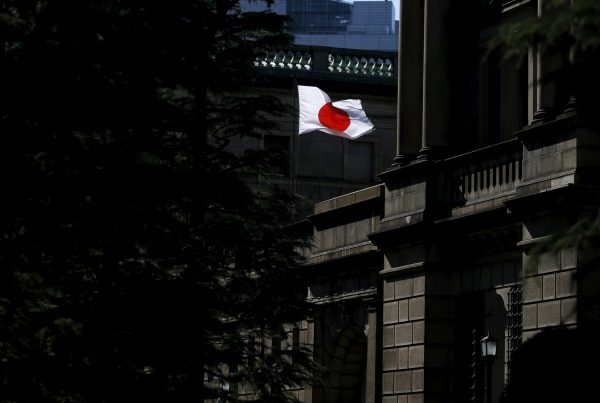With the government spending more than it taxes each year, debt continues to increase. But the markets have for two decades exhibited nothing but confidence in the government’s eventual ability to pay it down. Even with the mountain of government debt, three decades of slow growth and an ageing and shrinking population, global markets still see the Japanese yen as a safe haven. Whenever there’s a downturn in international confidence, the Japanese yen appreciates as investors buy more yen.
The Japanese government issues bonds to finance the debt, and Japan’s central bank (the Bank of Japan) and other institutional investors continue to buy them. Returns on Japanese government bonds are minimal or negative, even over ten years, as the interest rate has been at zero for the better part of two decades. So servicing the debt is cheap for the government, for now. If the Bank of Japan succeeds in reaching its 2 per cent inflation target, it will become more expensive to service the debt.
Many investors have lost fortunes betting against Japanese government bonds. But how much longer can this build up of debt financed by government bonds continue? The larger the gross debt becomes, the harder it will be to bring it down.
The good news is that almost all of that debt is held domestically and the government holds a large amount of net foreign assets.
Yet Japan is not immune from a fiscal crisis, and given Japan’s systemic importance to the global economy, it could be the source of a larger debt crisis. Even if Japan were not the source of a crisis, the government lacks the monetary and fiscal space — with interest rates still stuck at the zero lower bound and the government running fiscal deficits — that it would need to provide a policy buffer.
In this week’s lead essay, Takashi Oshio explains some of the potential tipping points in structural trends with which Japanese policymakers will have to reckon with. The domestic savings that have helped fund bond purchases will continue to fall with Japan’s ageing population — the elderly are a large and growing proportion of the population, and they earn and save less. Japan’s current account surplus will head into deficit eventually, and the marginal debt holder will be foreign, not Japanese.
‘If gross government debt keeps climbing at a faster pace than household net financial assets’, Oshio explains, ‘it will become more difficult to absorb newly issued government bonds in the market’. And this ‘may trigger a punitive increase in the interest rate, which could immediately threaten debt sustainability’.
If interest rates shoot up, the Bank of Japan could bail the government out by buying large quantities of government bonds, though this would cause high inflation and bring down the real value of debt. High inflation would be very disruptive and is precisely what the Bank of Japan is mandated to avoid.
Masahiko Takeda reminds us that there are only four ways to reduce Japan’s high public debt. High inflation is one way, and this would avoid the second way: for the government to default on its debt. The other two debt reduction strategies — for Japan to grow its way out with high economic growth or to run primary budget surpluses by spending less than it taxes — would be the best but are the most difficult to achieve.
Oshio recommends the most obvious solution: gradually eating down the debt with a more ‘aggressive but prudential strategy of fiscal consolidation’ that contains government spending, expands labour force participation and increases tax and social security contributions. That should have started at least a decade ago, but it is not too late.
These measures will not be easy politically. Tax increases are difficult anywhere and the large elderly population in Japan builds in strong resistance to reducing social security spending. But time is running out as household savings fall, and the risks in the global economy are on the downside with the United States and China locking in to a trade war that will be difficult to weather.
Japan’s government debt is sustainable only so long as the market believes it is. To maintain that confidence, the trajectory of that debt needs to be reversed. Government projections have been of higher growth and eventual primary fiscal surpluses, but in reality, the Japanese economy has continued to come up short.
Japan faces some difficult decisions and its course will need to be corrected to avoid what presently looks like a slow-motion train-wreck.
The EAF Editorial Board is located in the Crawford School of Public Policy, College of Asia and the Pacific, The Australian National University.

